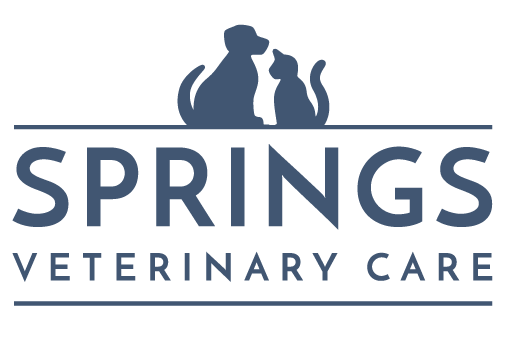If you’ve ever done an Internet search for “best dog food” or “best cat food,” you know how many choices there are. Dry, canned, homemade, raw, freeze-dried. And that’s not even considering how many different brands there are.
When it comes to giving your pet the best possible diet, your best resource is your Springs Veterinary Care veterinarian! Here are our food recommendations.
Choosing for a life stage
The first step in choosing a food for your dog or cat is to consider your pet’s life stage: puppy/kitten (up to 1 year old), adult (between 1 and 7 years old), senior (7 years or older), or nursing/pregnant.
Foods that claim to be “for all life stages” might not give your pet the nutrition they need, especially if you have a very young pet, or a pregnant female. Choose a food expressly designed for your pet’s life stage.
Choosing a food type
There are several types of pet foods. Here’s a breakdown of each:
Dry food and canned food are the most popular choices among American pet owners. Using a good quality dry or canned food is a good choice for your pets. Both have long shelf lives, and each has adequate nutrients (if the food is good quality). Dry food typically is cheaper than canned food, but both are fairly affordable.
Homemade diets are a good option if you don’t mind extra time and expense. It isn’t as simple as sharing your dinner with your pets. Commercial foods undergo testing and research to guarantee proper nutrition. If you choose a homemade diet, you don’t have that advantage, and it can be difficult to ensure your pet is getting all the nutrients he or she needs, such as calcium, copper, iodine, fat-soluble vitamins, and B vitamins. Work with us to formulate a home-cooked diet that is properly balanced, meets all nutritional needs, and is suitable for your pet’s age, lifestyle, and condition.
Raw diets have gained traction in recent years. However, the American Animal Hospital Association (AAHA), American Veterinary Medical Association (AVMA), and the Canadian Veterinary Medical Association (CVMA) have all released statements discouraging the feeding of raw or undercooked animal-source protein to dogs and cats. The Delta Society’s Pet Partners Program has a policy preventing animals on raw meat-based diets from participating in the Therapy Animal Program. There are many reasons for this – there are potentially harmful pathogens in raw meat, raw meat poses the risk of salmonella, raw bones have been associated with dental problems in dogs, and raw diets are often nutritionally imbalanced.
Choosing the perfect recipe
With your pet’s life stage and the type of food you want to use in mind, you’re ready to choose a food! Call Springs Veterinary Care at 512-829-6140 to make an appointment so one of our veterinarians can give you recommendations for brands, food types, and portion sizes.
Why ask for professional help? With so many brands and types and styles of food out there, just getting a best brand recommendation from one of our doctors can narrow your search significantly and get you on the path to the healthiest diet for your pet.
It’s not just new pets who need nutrition evaluations, either. Nutritional needs change with age, and with the development of certain issues such as dental disease, bladder stones, obesity, joint pain, and more.
If you’re buying a bag of kibble from the pet store, the bag has all the information you need. Per current U.S. pet food regulations, pet food labels must list:
- Product name
- Net weight
- Name and address of manufacturer
- Guaranteed analysis
- List of ingredients
- The words “dog” or “cat” food
- Statement of nutritional adequacy
- Feeding guidelines
- Calorie content of the diet expressed in both kcal/ME/kg and familiar household unit (e.g., cups or cans)
Ingredients listed in a product name tell you a lot about the percentage of that ingredient in the product. For example, using the term “beef” in a product name means beef must make up at least 70% of the total product. However, “beef dinner,” “beef entrée,” “beef platter,” etc., implies that beef is only 25% or more of the total product. “With beef” indicates even less beef, 3% or more, and “beef flavor” indicates the least amount of beef.
The ingredient list is important, but perhaps not in the way you think. Ingredients are listed in descending order of weight, but ingredient lists do not state quality or grade of ingredients. So, the food may list chicken first, but the chicken may be mostly moisture, and will contribute to a much smaller percentage of total nutrients than the dry matter (e.g., corn) does. A dry matter assessment is best. The ingredient list is most helpful to see where the protein and carbs are coming from in your pet’s food – helpful if, say, your pet has a food allergy.
When choosing a food, look for the Association of American Feed Control Officials (AAFCO) statement on the bag to check if it was formulated (someone made the recipe with the requirements) to meet needs, or if it has been tested through feeding trials (the company made the recipe then tested it in a feeding trial, then monitored the animals over time to make sure there were no metabolic issues with the food). We recommend only those foods that have been proven through AAFCO standards and feeding trials.
Remember: Expensive food does not always equal good food.
Any time you have a question about your pet’s diet, don’t rely on questionable online sources. Our veterinarians are nutritional experts who can give you the facts! Call us at 512-829-6140!
